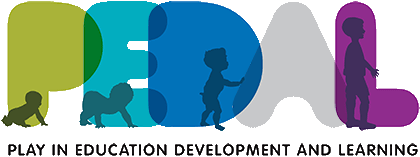We may not remember much about our lives as babies or toddlers, but this time of growth and development provides moments of both opportunity and vulnerability. What happens early on can shape our experiences into adulthood. Early interventions are programmes that support children in these first few years, striving to give them the best start in life.
There are multiple early childhood programmes in the UK, and their aims vary a lot – from supporting children’s social and emotional skills, to enhancing learning and improving health. Some focus on trying to help children in need of extra support, and others aim to benefit all children. Programmes can take place at home, in schools or nurseries, within health services, or in children’s centres. Some work with just the child, and others work with the child’s siblings, parents, carers or teachers.
It’s common for early interventions to measure if they’ve worked immediately after the programme finishes, and a lot of evidence suggests that these programmes can bring about short-term benefits for children. This may include better performance in nursery or school, increased social and emotional skills, or improved health1–3. But what about the long-term effects of these programmes? Do the benefits of participating in an early intervention last through the child’s school and teenage years?
What we (are yet to) know
Time, funding and logistical constraints make it more challenging to assess how well these programmes work in the long run, meaning that our knowledge is limited. Researchers who have looked into this have found mixed results.
Sometimes, the effects of an intervention are seen to fade out – the gap found between children who have and haven’t participated in an intervention immediately after the programme finishes gets smaller as time goes on. This appears to be particularly the case for programmes targeting children’s early learning, including their language, literacy and maths skills. In time, children who haven’t participated in the intervention may catch up with those that have4-5.
At other times, the positive effects continue and the benefits created by the intervention are maintained. Recent research suggests that this could be the case for programmes supporting families with children who are experiencing behavioural difficulties. Sustained reductions in child behaviour problems have been found for up to three years after a parenting programme finishes6.
Alternatively, interventions may generate (sometimes unexpected) effects that don’t appear until several years later. For example, some programmes have resulted in long-term effects in adolescence and adulthood, such as decreased anti-social behaviour and lower involvement in crime7-8. What exactly causes these effects is a question for further investigation.
In sum, the long-term effects of early interventions can vary and we still have lots to learn.
What might increase long-term impact?
Given the mixed and limited evidence on the long-term effects of early interventions, some researchers have tried to understand what might explain these differences, and how long-term impact can be maximised.
The purpose of the intervention9:
Early interventions may have a greater chance of making a long-term difference if the skills and behaviours they target are easy to improve, fundamental to children’s later success, and unlikely to develop without an intervention.
A broad concept like ‘overall intelligence’, for example, can be difficult to shape, but children’s maths and literacy skills are more easily increased. Ensuring the focus is on developing skills or behaviours that are actually beneficial for children is also key. Whilst becoming ambidextrous might be cool, it’s unlikely to have an impact on children’s later achievements. Meanwhile, things like motivation to learn, social and emotional skills, and maths and literacy abilities are really important for many areas of children’s future lives. Finally, targeting skills that children wouldn’t otherwise have the opportunity to develop may lead to a longer-term positive effect. For example, the benefits of some interventions targeting children’s early maths and literacy skills may fade over time because children eventually learn these skills through their nurseries and schools anyway. Designing interventions to complement any existing support that children will receive during their early years is important.
When the intervention takes place9:
Timing interventions to support children during particularly challenging or vulnerable times, or to provide them with key skills at important moments, may increase the chance of a programme creating a lasting benefit. An example of this is programmes that help children to get ready for or settle into school. A good start in school can set children on the path to enjoying learning and their time in the classroom, which may lead to a series of positive knock-on effects that changes their long-term route through education.
What happens after the intervention9–11:
Thinking about the environment that children are in after a programme ends is important for making sure that any benefits created can last as the child grows. A single programme won’t solve all of the varied challenges that families can face. Children in need of extra help are more likely to attend schools with lower academic attainment and live in communities that have fewer resources and experience more hardship. Considering and preparing for these challenges is key. Providing ongoing support and monitoring for children who might need extra help (a bit like dental check-ups), could be more effective in the long-term than programmes that occur once.
Next steps
We’re working to learn more about the long-term effects of early interventions, including when and how they occur.
If you’re interested in finding out more about particular programmes, have a look at the Early Intervention Foundation and Education Endowment Foundation’s resources12-13. These guides have a simple rating system to show how strong the evidence for a programme is and how much it costs. There’s lots to look through with over 100 programmes included!

References
1How does early childhood care and education affect cognitive development? An international review of the effects of early interventions for children from different social backgrounds (Burger, 2010)
2Meta-analysis of the effects of early education interventions on cognitive and social development (Camilli et al., 2010)
3Investing Early (Cannon et al., 2018)
4Facts about Fadeout: The Research Base on Long-Term Impacts of High Quality Pre-K (Barnett & Carolan, 2014)
5Investing in our future: The evidence base on preschool education (Yoshikawa et al., 2013)
6Sustained, fade-out or sleeper effects? A systematic review and meta-analysis of parenting interventions for disruptive child behaviour (van Aar et al., 2017)
7Charting Intervention Effects Over Time (Emde, 2003)
8Lifetime effects: The High/Scope Perry Preschool study through age 40 (Schweinhart et al., 2005)
9Persistence and Fadeout in the Impacts of Childhood Intervention Programs (Bailey et al., 2017)
10Do You Believe in Magic?: What We Can Expect From Early Childhood Intervention Programs (Brooks-Gunn, 2003)
11Prevention of Problem Behaviour Through Annual Family Check-Ups in Early Childhood: Intervention Effects from Home to Early Elementary School (Dishion et al., 2014)
12EIF Guidebook (Early Intervention Foundation)
13Early Years Toolkit (Education Endowment Fund)
